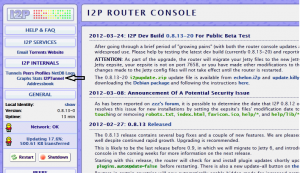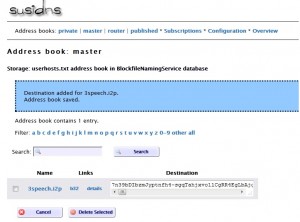Posts Tagged I2P
Hosting on I2P
Posted by drakopoulos in Technical Details on May 3, 2012
The default install of I2P comes with a Jetty web daemom, so starting up the eepsite is actually incredible easy. On the router console homepage, in the left hand bar there is a link to the I2PTunnel under the heading I2P Internals.
Once inside, in the I2P Server Tunnels section, you will see the default eepsite. Click the start button, and wait for it to start up.
On Windows, at this location: C:\Program Files\i2p\eepsite is where you will find the index.html file of the eepsite. There are some redirect to help instructions in the file, once those are deleted things are good to go.
Of course, the destination of the eepsite is on the local host and it will be difficult for other people to find because it doesn’t have a name and they don’t have your really long Base64 key. You could just tell people that really long key, but thankfully I2P has an address book and several easy ways to tell people about your eepsite.
First, enter the new name of the eepsite on the eepsite i2ptunnel configuration page where it says “Website name”. This will replace the default “mysite.i2p”.
Highlight the entire “Local destination” key on the eepsite i2ptunnel configuration page and copy it for later pasting. Make sure you get the whole thing – it’s over 500 characters and it must end in “AAAA”. Enter the name and paste in the destination key into your master address book. Click “Add” to add the destination to your address book.
The final step is registering the eepsite in an address book hosted by i2p, which is part of the NetDB (explained in the about I2P post). Go to stats.i2p. Again, your key is the entire “Local destination” key on the eepsite i2ptunnel configuration page. After adding it, we can check to see if it reports the key was added. Since many routers periodically get address book updates from these sites, within several hours others will be able to find your website by simply typing 3speech.i2p into their browser.
We also used this video to learn how to host an eepsite by creating a new HTTP server tunnel and to map it to a virtual host rather than use the default Jetty. We did not actually do this because we do not have an external server to use.
Connecting to I2P
Posted by drakopoulos in Technical Details on April 19, 2012
The following tutorials were used to learn how to connect to the I2P network and how to implement any necessary configurations:
Installing on Windows:
http://www.youtube.com/watch?v=WyN_QK-_3GA
Further information can be found here.
Installing on Linux:
Installing on Apple OSX:
Network Selection
Posted by drakopoulos in Technical Details on April 19, 2012
Having examined the existing anonymous networks and discussing the options in a group meeting, we narrowed down our choices to either the TOR network or the I2P network. We then proceeded to examine the various strengths and weaknesses of the two networks, before finally settling upon I2P. Below are the technical factors that lead us to our choice:
- I2P is completely decentralized, unlike Tor where a ‘directory’ of the network is maintained. Rather than building an essentially trusted, centralised system with directory servers, I2P has a self-organizing network database with each peer taking on the responsibility of profiling other routers to determine how best to exploit available resources.
- While Tor was designed with the intention to enable anonymous Internet browsing, I2P’s focus is to provide an anonymous network, isolated inside the Internet, off ering various protocols and applications within. Furthermore, I2P is designed and optimised for “hidden services” (i.e. websites and other services hosted within I2P), and they are much faster than the corresponding ones on the Tor network, as the I2P network is fully distributed and self-organizing.
- Content hosted on networks such as Freenet are mostly static, whereas websites hosted within I2P can be fully dynamic
- I2P is fundamentally a packet switched network whereas Tor is fundamentally a circuit switched network. This allows I2P to transparently route around congestion and other network failures, operate redundant pathways and load balance the data across available resources.
- Although Tor is more popular and has significantly more funding than the I2P network, in recent times the network has become incredibly saturated and is more vulnerable. In contrast, the smaller size of I2P has allowed it thus far to float beneath the radar of government censors and malicious users.
- The unidirectional tunneling system used by I2P doubles the amount of nodes that a peer needs to compromise to get the same information that could be obtained from Tor’s bidirectional tunneling system. In addition to this, tunnels in I2P are short lived, decreasing the number of samples that an attacker can use to mount an active attack with, unlike circuits in Tor, which are typically long lived.
Architecture of I2P (the following section was taken from the technical documentation of I2P, located here):
How it works:
I2P uses bundled encryption over a multi-proxy like Tor. The packets are bounced all over the globe using I2P. However, the packets are encrypted with EIGamal and AES encryption. Using bundled encryption like this allows a packet to only decrypt the next hop as it passes through various nodes on its path. Once inside the network, IP addresses are not even used. Your node is assigned an address of garbled text to use an identifier.
I2P uses virtual, unidirectional tunnels that pass through a series of routers, and are typically 2 to 3 hops. Each round trip message and reply will require 4 tunnels. One for each the sender and receivers inbound/outbound traffic. Tunnels are created using what is known as ‘garlic routing’. A tunnel build message is sent via garlic routing to an I2P router requesting that it participate in a tunnel.
I2P makes a strict separation between the software participating in the network (a ‘router’) and the anonymous endpoints (‘destinations’) associated with individual applications. The fact that somebody is running I2P isn’t usually a secret. What is hidden is the information on what the user is doing as well as what router a particular destination is connected to. End users will typically have several local destinations on their router.
Tunnels:
A tunnel is a directional path through an explicitly selected list of routers. Layered encryption is used, so each of the routers can only decrypt a single layer. The decrypted information contains the IP of the next router, along with the encrypted information to be forwarded. Each tunnel has a starting point (the 1st router (gateway)) and an endpoint. Messages can only be sent one way. To send messages back, another tunnel is required.
Two types of tunnels exist:
- “Outbound” tunnels send messages away from the creator.
- “Inbound” tunnels bring messages to the tunnel creator.
While the tunnels themselves have layered encryption to prevent unauthorized disclosure to peers inside the network (as the transport layer itself does to prevent unauthorized disclosure to peers in the network), it is necessary to add an additional end to end layer of encryption to hide messages from the outbound tunnel endpoint endpoint and the inbound tunnel gateway. This achieved by a process known as ‘garlic routing’.
Garlic Routing:
I2P uses an extension of the well-known onion routing approach, in which a message is routed from its originator to the final endpoint through several intermediate nodes using layered encryption. The originator adds to the message to be sent an encryption layer for every node in the path, each intermediate node peels off one of these layers, exposing routing instructions along with still-encrypted payload data, and finally the last node removes the final layer of encryption, exposing the original message to the endpoint. This process is called garlic routing, and allows to the originator include several messages in a single onion. I2P currently uses this approach to include the return destination for a given message as well as status messages.
The ‘instructions’ attached to each clove inside the encryption layer includes the ability to request that clove be forwarded locally, to a remote router, or to a remote tunnel on a remote router. There are fields in those instructions allowing a peer to request that a delivery be delayed until a certain time or condition has been met, though they won’t be honoured until the non-trivial delays are deployed.
Network Database (NetDB):
The NetDB uses a pair of algorithms which are used to share network metadata. The two types of metadata carried are “routerinfo” and “leasesets” – the routerinfo gives routers the data necessary for contacting a particular router (their public keys, transport address etc.) while the leaseset give routers the information necessary for contacting a particular destination. The full info contained in the leaseset is:
- Inbound gateway for a tunnel that allows reaching a specific destination.
- Time when a tunnel expires.
- Pair of public keys to be able to encrypt the messages (to send through the tunnel).
Routers themselves send their router information to the netDB directly, while leasesets are sent through outbound tunnels (leasesets need to be sent anonymously, to avoid correlating a router with his leaseset).
The following sources were used for this post:
Invisible Internet Project (I2P)
Posted by drakopoulos in Existing Similar Tools on April 17, 2012
I2P is an anonymizing network, offering a simple layer that identity sensitive applications can use to securely communicate. All data is wrapped with several layers of encryption, and the network is both distributed and dynamic, with no trusted parties. I2P is designed to allow peers using I2P to communicate with each other anonymously – both sender and receiver are unidentifiable to each other as well as to 3rd parties. It can be used for anonymous: web surfing, chatting, blogging and file transfers.
The I2P network, a low-latency message oriented anonymous network was mainly designed to allow a fully anonymous conversation between two parties with the I2P network limits. The network itself is strictly message based (like IP), but there is a library available to allow reliable streaming communication on top of it (like TCP).
ALL communication is end-to-end encrypted (total of 4 layers of encyption) and even end-points are cryptographic identifiers (public keys) so that neither sender nor recipient of a message need to reveal their IP address to the other side (or to 3rd parties).
The network is formed of a group of routers. A router runs the software that allows any application to communicate through I2P. Applications running on top of it will have a destination associated, which receives incoming connections from third parties. The secret lies in which destination is associated to which router and not in the fact that a user is running an instance of the router. This uncoupling between the router and the destinations provides a certain degree of anonymity. The decentralized nature of the network prevents a single point of failure and adds another element of anonymity, as every client also acts as a server on the network.
The network itself is message oriented, in other words it is essentially a secure and anonymous IP layer, where messages are cryptographic keys (destinations) and can be significantly larger than IP packets. Furthermore, I2P has no official entry/exit points (in contrast to Tor), all peers participate in the mix, and there isn’t any network layer in or out proxies (however at the application layer, a few proxies exist).
How it works:
I2P uses bundled encryption over a multi-proxy like Tor. The packets are bounced all over the globe using I2P. However, the packets are encrypted with EIGamal and AES encryption. Using bundled encryption like this allows a packet to only decrypt the next hop as it passes through various nodes on its path. Once inside the network, IP addresses are not even used. Your node is assigned an address of garbled text to use an identifier.
I2P uses virtual, unidirectional tunnels that pass through a series of routers, and are typically 2 to 3 hops. Each round trip message and reply will require 4 tunnels. One each for the sender and receiver’s inbound/outbound traffic. Tunnels are created using what is known as ‘garlic routing’. A tunnel build message is sent via garlic routing to an I2P router requesting that it participate in a tunnel.
I2P makes a strict separation between the software participating in the network (a ‘router’) and the anonymous endpoints (‘destinations’) associated with individual applications. The fact that somebody is running I2P isn’t usually a secret. What is hidden is the information on what the user is doing as well as what router a particular destination is connected to. End users will typically have several local destinations on their router.
This summary was written using the following sources:
[1] I2P Homepage
[2] I2P Tech Intro
[3] I2P Tunnel
[4] Getting Started On The I2P Darknet
[5] I2P – The *other* Anonymous Network
Meeting #3
Posted by drakopoulos in Group Meetings on March 21, 2012
Having decided on what we would be building (an anonymous social network), this meeting was focused on discussing the technical details of 3speech. From the previous meeting, we had assigned a network to each member to research (Tor, I2P, Freenet etc.), using this research we created a list of pros and cons for each and then had a group discussion about which network we should select. After much debate, we narrowed it down to either Tor or I2P and ultimately settled on I2P.
For the remainder of the meeting, we started creating some storyboards for potential users.







